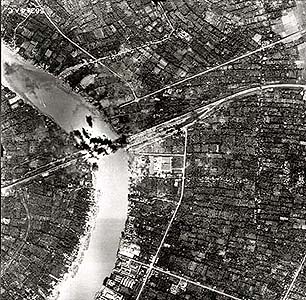 W
WThe city of Bangkok, Thailand was bombed by the Allies on numerous occasions during World War II. It was also the target for the first combat mission by Boeing B-29 Superfortresses in June 1944.
 W
WThe Burma campaign in the South-East Asian Theatre of World War II took place over four years from 1942 to 1945. During the first year of the campaign, the Imperial Japanese Army with aid from Burmese insurgents had driven British forces and Chinese forces out of Burma, and occupied most of the country. From May to December 1942, most active campaigning ceased as the monsoon rains made tactical movement almost impossible in the forested and mountainous border between India and Burma, and both the Allies and Japanese faced severe logistical constraints.
 W
WThe fighting in the Burma campaign in 1944 was among the most severe in the South-East Asian Theatre of World War II. It took place along the borders between Burma and India, and Burma and China, and involved the British Commonwealth, Chinese and United States forces, against the forces of Imperial Japan and the Indian National Army. British Commonwealth land forces were drawn primarily from the United Kingdom, British India and Africa.
 W
WThe Burma campaign was a series of battles fought in the British colony of Burma. It was part of the South-East Asian theatre of World War II and primarily involved forces of the Allies; the British Empire and the Republic of China, with support from the United States. They faced against the invading forces of Imperial Japan, who were supported by the Thai Phayap Army, as well as two collaborationist independence movements and armies, the first being the Burma Independence Army, which spearheaded the initial attacks against the country. Puppet states were established in the conquered areas and territories were annexed, while the international Allied force in British India launched several failed offensives. During the later 1944 offensive into India and subsequent Allied recapture of Burma the Indian National Army, led by revolutionary Subhas C. Bose and his "Free India", were also fighting together with Japan. British Empire forces peaked at around 1,000,000 land and air forces, and were drawn primarily from British India, with British Army forces, 100,000 East and West African colonial troops, and smaller numbers of land and air forces from several other Dominions and Colonies.
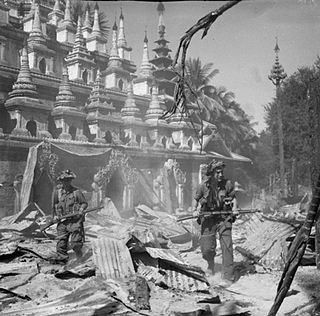 W
WThe Burma campaign in the South-East Asian Theatre of World War II was fought primarily by British Commonwealth, Chinese and United States forces against the forces of Imperial Japan, who were assisted to some degree by Thailand, the Burmese National Army and the Indian National Army. The British Commonwealth land forces were drawn primarily from the United Kingdom, British India and Africa.
 W
WThe Japanese invasion of Burma was the opening phase of the Burma campaign in the South-East Asian theatre of World War II, which took place over four years from 1942 to 1945. During the first year of the campaign, the Japanese Army drove British Empire and Chinese forces out of Burma, then began the Japanese occupation of Burma and formed a nominally independent Burmese administrative government.
 W
WForce 136 was the general cover name, from March 1944, for a Far East branch of the British World War II intelligence organisation, the Special Operations Executive (SOE). Originally set up in 1941 as the India Mission with the cover name of GSI(k), it absorbed what was left of SOE's Oriental Mission in April 1942. The man in overall charge for the duration of the war was Colin Mackenzie.
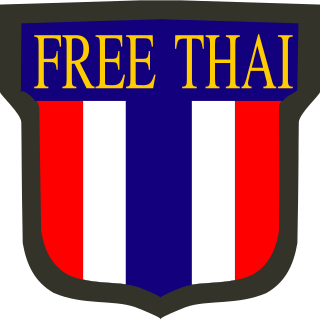 W
WFree Thai Movement was a Thai underground resistance movement against Imperial Japan during World War II. Seri Thai were an important source of military intelligence for the Allies in the region.
 W
WThe Franco-Thai War was fought between Thailand and Vichy France over certain areas of French Indochina.
 W
WThe Japanese invasion of Thailand occurred on 8 December 1941. It was briefly fought between the Kingdom of Thailand and the Empire of Japan. Despite fierce fighting in Southern Thailand, the fighting lasted only five hours before ending in a ceasefire. Thailand and Japan then formed an alliance, making Thailand part of the Axis' alliance until the end of World War II.
 W
WThe Karenni States, also known as Red Karen States, was the name formerly given to the states inhabited mainly by the Red Karen, in the area of present-day Kayah State, eastern Burma. They were located south of the Federated Shan States and east of British Burma.
 W
WKengtung, known as Menggen Prefecture or Möng Khün Chiefdom or Mueng Khuen Fu from 1405 to 1895, was a Shan state in what is today Burma. The capital and the residence of the ruler was Kengtung in the centre of the state. It was the only urban area in this mountainous state whose landscape is dominated by the Daen Lao Range.
 W
WOperation Krohcol, or the Battle for The Ledge, was a British operation in December 1941 to invade southern Thailand following the Japanese invasion of Malaya and of Thailand during World War II. It was authorised by Lieutenant-General Arthur Percival as a "mini Matador" after Operation Matador, a pre-emptive strike into Thailand which had been opposed by the British government and was not carried out. Due to delays in authorisation by Percival and in the forwarding of his order, the need to reorganise the troops for Krohcol instead of Matador, and resistance from Thai policemen the Krohcol column did not reach the Ledge in time.
 W
WPhayap Army was the Thai force that invaded the Shan States of Burma on 10 May 1942 during the Burma Campaign of World War II.
 W
WField Marshal Plaek Phibunsongkhram, locally known as Marshal P., contemporarily known as Phibun (Pibul) in the West, was a Thai military officer and politician who served as the Prime Minister of Thailand from 1938 to 1944 and 1948 to 1957.
 W
WThe Battle of Prachuap Khri Khan was an early engagement of the Japanese invasion of Thailand in the Southeast Asian theatre of World War II. It was fought on 8–9 December 1941 at the airfield of Prachuap Khiri Khan, on the coast of the Gulf of Thailand along the Kra Isthmus. The Japanese meant to use Thailand as a base to strike at British possessions in Burma and Malaya and attacked Thailand without warning.
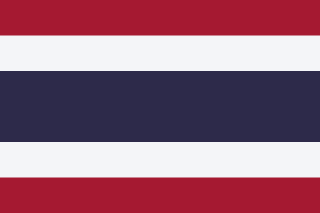 W
WSaharat Thai Doem was an administrative division of Thailand. It encompassed parts of the Shan States of British Burma annexed by the Thai government after the Japanese conquest of Burma.
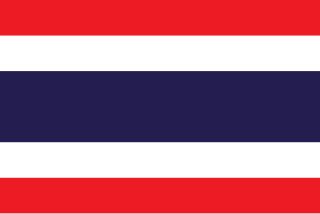 W
WSi Rat Malai is a former administrative division of Thailand. It included the four northern states of Kedah, Perlis, Kelantan, and Terengganu in British Malaya annexed by the Axis-aligned Thai government after the Japanese invasion of Malaya.
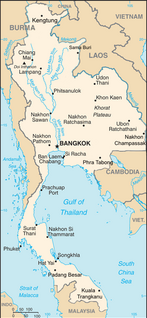 W
WThailand in World War II officially adopted a position of neutrality until the five hour-long Japanese invasion of Thailand on 8 December 1941 which led to an armistice and military alliance treaty between Thailand and the Japanese Empire in mid-December 1941. At the start of the Pacific War, the Japanese Empire pressured the Thai government to allow the passage of Japanese troops to invade British-held Malaya and Burma. The Thai government under Plaek Phibunsongkhram considered it profitable to co-operate with the Japanese war efforts, since Thailand saw Japan – who promised to help Thailand regain some of the Indochinese territories which had been lost to France – as an ally against Western imperialism. Axis-aligned Thailand declared war on the United Kingdom and the United States and annexed territories in neighbouring countries, expanding to the north, south, and east, gaining a border with China near Kengtung.
 W
WVictory Monument is a military monument in Bangkok, Thailand. The monument was erected in June 1941 to commemorate the Thai victory in the Franco-Thai War. The monument is in Ratchathewi District, northeast of central Bangkok, at the center of a traffic circle in the intersection of Phahonyothin, Phaya Thai and Ratchawithi roads.